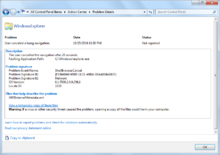- Windows Error Reporting
-
Windows Error Reporting (WER) (codenamed Watson) is a crash reporting technology introduced by Microsoft with Windows XP[1] and included in later Windows versions and Windows Mobile 5.0 and 6.0. Not to be confused with the Dr. Watson debugging tool which left the memory dump on the user's local machine, Windows Error Reporting collects and offers to send post-error debug information (a memory dump), using the Internet, to the developer of an application that crashes or stops responding on a user's desktop. No data is sent without the user's consent. When a dump (or other error signature information) reaches the Microsoft server, it is analyzed and a solution is sent back to the user when one is available. Solutions are served using Windows Error Reporting Responses. Windows Error Reporting runs as a Windows service and can optionally be entirely disabled. If Windows Error Reporting itself crashes, then an error reports that the original crashed process cannot be sent.
Contents
History
Windows XP
Microsoft first introduced Windows Error Reporting with Windows XP[1].
Windows Vista
Windows Error Reporting was improved significantly in Windows Vista. Most importantly a new set of public APIs have been created for reporting failures other than application crashes and hangs.[2] Developers can create custom reports and customize the reporting user interface. The new APIs are documented in MSDN. The architecture of Windows Error Reporting has been revamped with a focus on reliability and user experience. WER can now report errors even when the process is in a very bad state for example if the process has encountered stack exhaustions, PEB/TEB corruptions, heap corruptions etc. In earlier OSs prior to Vista, the process usually terminated silently without generating an error report in these conditions. A new Control Panel applet, "Problem Reports and Solutions", was also introduced, keeping a record of system and application errors and issues, as well as presenting probable solutions to problems.
Windows 7
The Problem Reports and Solutions Control Panel applet was replaced by the Maintenance section of the Windows Action Center on Windows 7 and Server 2008 R2.
Third-party software
Software and hardware manufacturers may access their error reports using Microsoft's Winqual program.[3] In order to ensure that error reporting data only goes to the engineers responsible for the product, Microsoft requires that interested vendors obtain a VeriSign Class 3 Digital ID. Digital certificates provided by cheaper providers (such as Thawte, DigiCert, Comodo, GlobalSign, GeoTrust, Cybertrust, Entrust, GoDaddy, QuoVadis, Trustwave, SecureTrust, Wells Fargo) are not accepted.[4][5][6][7][8]
Software and hardware manufacturers can also close the loop with their customers by linking error signatures to Windows Error Reporting Responses. This allows distributing solutions as well as collecting extra information from customers (such as reproducing the steps they took before the crash) and providing them with support links.
Impact on future software
Microsoft has reported that data collected from Windows Error Reporting has made a huge difference in the way software is developed internally. For instance, in 2002, Steve Ballmer noted that error reports enabled the Windows team to fix 29% of all Windows XP errors with Windows XP SP1. Over half of all Microsoft Office XP errors were fixed with Office XP SP2.[9] Success is based in part on the 80/20 rule. Error reporting data reveals that there is a small set of bugs that is responsible for the vast majority of the problems users see. Fixing 20% of code defects can eliminate 80% or more of the problems users encounter. An article in the New York Times confirmed that error reporting data had been instrumental in fixing problems seen in the beta releases of Windows Vista and Microsoft Office 2007.[10]
Privacy concerns
Although Microsoft has made privacy assurances, they acknowledge that personally identifiable information could be contained in the memory and application data compiled in the 100-200K "minidumps" that Windows Error Reporting compiles and sends back to Microsoft. They insist that in case personal data is sent to Microsoft, it won't be used to identify users, according to Microsoft's privacy policy.[11][12] But in reporting issues to Microsoft, users need to trust Microsoft's partners as well. About 450 partners have been granted access to the error reporting database to see records related to their drivers, utilities and applications.[citation needed]
See also
References
- ^ a b Error Reporting Policies and Advanced Features
- ^ WER APIs
- ^ Winqual website
- ^ Introducing Windows Error Reporting
- ^ WinQual Registration Head Aches
- ^ Microsoft Support Forum: WER with Thawte authenticode signed app
- ^ The Old New Thing: How can a company get access to Windows Error Reporting data?
- ^ The great digital certificate ripoff?
- ^ Steve Ballmer's letter: Connecting to customers
- ^ A challenge for exterminators
- ^ Microsoft Privacy Statement for Error Reporting
- ^ Description of the end user privacy policy in application error reporting when you are using Office
Categories:- Microsoft Windows
- Windows Mobile
- Windows services
- Windows administration
- Software anomalies
Wikimedia Foundation. 2010.

